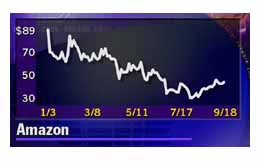|
Amazon's model doubted
|
 |
October 4, 2000: 3:34 p.m. ET
Robertson Stephens questions Amazon's diversification strategy
|
NEW YORK (CNNfn) - Amazon.com's strategy of having the "Earth's Biggest Selection," with merchandise across 14 different categories, could prevent the Web retailer from achieving sustainable long-term profitability, a prominent analyst said Wednesday.
Amazon's product line is too diversified, resulting in inefficient order processing and shipping, said Robertson Stephens analyst Lauren Cooks Levitan.
The securities firm conducted a research project that analyzed Amazon's efficiency at filling multi-category/multi-product orders. The conclusion was that Amazon (AMZN: Research, Estimates) lost an average of $2.91 per order, representing a negative 29.6 percent shipping margin, because it frequently filled an order from more than one distribution center.
"We believe our results raise legitimate concerns about Amazon's long-term strategy and are an early glimpse of issues which are likely to become more evident as Amazon increasingly attempts to cross-sell products to its huge customer base and increasingly stresses its complex distribution infrastructure," Levitan wrote in a research note issued Wednesday.
However, Levitan also said that Amazon could generate substantial long-term profit if the company makes some changes to its business model, and she kept her "long term attractive" rating on the stock. In an interview with CNNfn, she said that Amazon is still has some big advantages in the online shopping market. [381KB AIF] [381KB WAV]
 While Amazon's stock dipped early Wednesday, it was up 94 cents at $36 in late afternoon trading. While Amazon's stock dipped early Wednesday, it was up 94 cents at $36 in late afternoon trading.
Robertson Stephens placed test orders with Amazon about once a week, starting in mid-August, and tracked the orders through the fulfillment process. The firm received shipments from five of Amazon's eight U.S. distribution centers, and there was little consistency across orders regarding which distribution center fulfilled it. For every order Robinson Stephens placed, the firm received an average of 3.67 separate shipments.
In an interview with CNNfn, Levitan said the large number of items Amazon stocks could prevent it from achieving industry-leading metrics in its shipping operations. [411KB AIF] [411KB WAV]
"Split shipments are not always bad," responded Amazon spokesman Bill Curry. "We look for an optimum inventory level instead of having every item in every distribution center. It can be a better use of capital to occasionally do a split shipment instead of stocking every item in every center."
"Also, our most recently reported results show a positive margin on shipping," Curry added.
18 million items in 14 categories
Amazon started to diversify from selling just books, audio, and video in July 1999, when it went into consumer electronics and toys. Today, the Web retailer lists about 18 million items across 14 categories. Amazon is one of the only major Web sites where one can order a hammer, a lawn chair, a yo-yo, and a best-selling novel all at the same time. Amazon stocks about 10.6 million of its 18 million items in its distribution facilities.
Levitan also criticized Amazon for having a lack of personalization in its marketing efforts.
"We believe Amazon is just scratching the surface of its opportunity to use each product shipment as a direct marketing tool," she wrote. "In our view, each order represents a data point about our purchase behavior. Yet, we were surprised by the lack of personalization of promotional inserts included with our orders."
Amazon does use a high degree of personalization, however, when it makes book, video, and music recommendations on its home page. Those recommendations are based on purchases that each customer has made in the past. However, if a customer buys a copy of "Guide to Owning a Gerbil" as a one-time gift for a friend, that may result in rodent-related books being part of his recommendations for weeks to come.
Levitan concluded that Amazon will need to make several changes to its business model to address what she calls its "breadth-efficiency conundrum." Those changes include: having a smaller assortment of goods in its more recent categories, such as lawn and patio; more partnerships with other Web retailers; more deals that resemble Amazon's co-branded site with Toysrus.com; and greater emphasis on merchandising and product suggestion.
"While we continue to believe that the online advantages can surely drive superior returns and profitability, we believe Amazon's breadth-efficiency conundrum is likely to eat into these gains unless business model revisions are made," Levitan wrote.
"The report comes to a conclusion that Amazon is still 'long-term attractive,'" Amazon's Curry responded. "We've told people in the past that Amazon stock will be volatile in the short-run and that it is not a good stock for short-term investors. We recommend that short-term investors not buy our stock because we are a long-term play." 
|
|
|
|
|
 |

|

